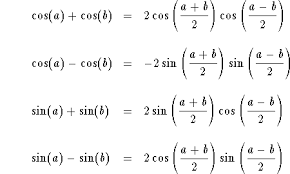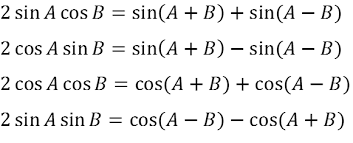Products, Sums, Linear Combinations, and Applications
Key Questions
-
Main approach to solve a trig equation : Use Trig Transformation Identities to transform it to a product of a few basic trig equations. Solving a trig equation finally results in solving a few basic trig equations.
Transformation Trig Identities that convert Sums to Products .
1. cos a + cos b = 2cos (a +b)/2cos (a - b)/2
2. cos a - cos b = -2sin (a + b)/2sin (a - b)/2
3. sin a + sin b = 2sin (a + b)/2cos (a - b)/2
4. sin a - sin b = 2cos (a + b)/2sin (a - b)/2
5. tan a + tan b = sin (a + b)/cos acos b.
6. tan a - tan b = sin (a - b)/cos acos b
Example 1 . Transform f(x) = sin a + cos a to a product.
Solution. Use Identity (3) to transform f(x) = sin a + sin (Pi/2 - a) = 2sin (Pi/4)sin (a + Pi/4)
Example 2 . Transform f(x) = sin x + sin 3x + sin 2x to a product. Use Identity (3) to transform the sum (sin x + sin 3x), then put in common factor.
f(x) = (2sin 2acos a) + 2sin acos a = 2cos a(2sin 3a/2*cos a/2) -
Answer:
Substitute
# a cos x + b sin x = sqrt{a^2 + b^2} cos(x -text{arctan2}( b //, a) ) # where arctan2 is the two parameter, four quadrant inverse tangent.
Explanation:
I've been answering all these old math questions. It's hard to know if anyone reads the answers.
The linear combination of a cosine and a sine of the same angle corresponds to a scaling and a phase shift. Let's explain how that works.
The linear combination of a cosine and a sine of the same angle is an expression of the form:
# a cos x + b sin x # That looks very much like the sum angle formula for sine or the difference angle formula for cosine:
# sin(alpha + beta ) = sin alpha cos beta + cos alpha sin beta # # cos(alpha - beta) = cos alpha cos beta + sin alpha sin beta# Indeed, we can take our linear combination and transform it into a scaled version of either of these. Pro Tip: When given a choice, prefer cosine to sine.
Let's multiply by a scale factor
#r# and set#alpha = x, beta=theta.# # r cos(x - theta) = r cos theta cos x + r sin theta sin x# Matching to our linear combination leads us to want to solve for
#r# and#theta# :#a = r cos theta# #b = r sin theta# We've seen this before. It's how we turn turn the polar coordinates
#P(r, theta)# to rectangular coordinates, here#(a,b).# So our task is to turn#(a,b)# to polar coordinates.Let's remind ourselves how to do that, perhaps in a bit more detail than usually seen.
Squaring and adding we get
#a^2 + b^2 = (r cos theta)^2 + (r sin theta)^2 = r^2(cos^2 theta + sin^2 theta) = r^2# # r = sqrt{a^2 + b^2}# #sin theta = b/r# #cos theta = a/r# #tan theta = b/a# #theta = text{arctan2}( b //, a)# Usually this is written as the regular arctangent, but that's not really right. The regular arctangent only covers two quadrants, and doesn't work on the y axis. This is the two parameter, four quadrant inverse tangent, which returns a valid theta for all real input pairs. The
#//,# is deliberate, reminding us there are two separate parameters, and which is which.So now we're assured
#a = r cos theta# and#b = r sin theta# so# a cos x + b sin x = r cos theta cos x + r sin theta sin x = r cos(x - theta) # # a cos x + b sin x = sqrt{a^2 + b^2} cos(x -text{arctan2}( b //, a) ) # -
Answer:
When at
#(71.06047^circ W, 43.08350^circ N) # a distant cell tower is at heading# 131^circ (SE)# , and at#(71.06137^circ W, 43.08007^circ N)# it's at heading#99^circ (E)# . Where is the tower?Explanation:
Someone from San Antonio requested an answer three years ago! Hope they've figured it out by now.
Here some real life trig I've been meaning to do. I wanted to know where that cell phone tower I can see from my house is. It's on a hill in the distance.
From one spot near my house, maybe the one in this picture, I pointed my phone at the tower with my GPS app on and got this:
The relevant information is:
#(71.06047^circ W, 43.08350^circ N) # heading# 131^circ (SE)# At another spot I got
#(71.06137^circ W, 43.08007^circ N)# heading#99^circ (E)# The heading is relative to due north. Here's a figure.
We treat west as negative. I translated the origin to #(-71.06, 43,08) and multiplied the coordinates by 100,000 so our new problem is:
#(-047, 350) # heading# 131^circ (SE)# #(-137, 007)# heading#99^circ (E)# Find Tower coordinates
#(x,y)# To solve we write the equations of the two lines and find the meet.
When measured relative to the y axis like that, the heading angle
#theta# converts to a slope as#m = cot theta# .So our two lines
#y - 350 = (x+47) cot 131 # #(y - 7)= (x+137) cot 99# meet when
# 350 + (x+47) cot 131 = 7+ (x+137) cot 99 # # x= {7 + 137 cot 99 -350 - 47 cot 131} /{cot 131 - cot 99} # x# x≈ 455.537# #y ≈-86.849 # That means my tower is at GPS coordinates
# (-71.06 +.00456, 43.08 - .000868) = (-71.0554, 43.07132)# Let's check Google Maps. Pretty good, off by around 400 feet.
-
Answer:
As below.
Explanation:
#color(blue)("Sum to Product Formulas"#
(
 )
) #color(green)("Product to Sum Formulas"#
(
 )
)